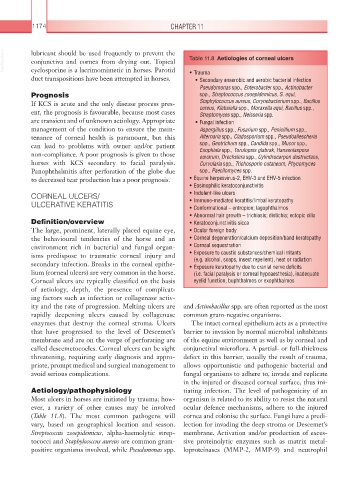Page 1199 - Equine Clinical Medicine, Surgery and Reproduction, 2nd Edition
P. 1199
1174 CHAPTER 11
VetBooks.ir lubricant should be used frequently to prevent the Table 11.8 Aetiologies of corneal ulcers
conjunctiva and cornea from drying out. Topical
cyclosporine is a lacrimomimetic in horses. Parotid
duct transpositions have been attempted in horses. • Trauma
• Secondary anaerobic and aerobic bacterial infection
Pseudomonas spp., Enterobacter spp., Actinobacter
Prognosis spp., Streptococcus zooepidemicus, S. equi,
If KCS is acute and the only disease process pres- Staphylococcus aureus, Corynebacterium spp., Bacillus
ent, the prognosis is favourable, because most cases cereus, Klebsiella spp., Moraxella equi, Bacillus spp.,
Streptomyces spp., Neisseria spp.
are transient and of unknown aetiology. Appropriate • Fungal infection
management of the condition to ensure the main- Aspergillus spp., Fusarium spp., Penicillium spp.,
tenance of corneal health is paramount, but this Alternaria spp., Cladosporium spp., Pseudoallescheria
can lead to problems with owner and/or patient spp., Geotrichum spp., Candida spp., Mucor spp.,
non-compliance. A poor prognosis is given to those Exophiala spp., Torulopsis glabrak, Hanseniaspora
euvarum, Drechslera spp., Cylindrocarpon destructans,
horses with KCS secondary to facial paralysis. Curvularia spp., Trichosporin cutaneum, Phycomyces
Panophthalmitis after perforation of the globe due spp., Paecilomyces spp.
to decreased tear production has a poor prognosis. • Equine herpesvirus-2, EHV-3 and EHV-5 infection
• Eosinophilic keratoconjunctivitis
CORNEAL ULCERS/ • Indolent-like ulcers
• Immune-mediated keratitis/limbal keratopathy
ULCERATIVE KERATITIS • Conformational – entropion; lagophthalmos
• Abnormal hair growth – trichiasis; distichia; ectopic cilia
Definition/overview • Keratoconjunctivitis sicca
The large, prominent, laterally placed equine eye, • Ocular foreign body
the behavioural tendencies of the horse and an • Corneal degeneration/calcium deposition/band keratopathy
environment rich in bacterial and fungal organ- • Corneal sequestration
isms predispose to traumatic corneal injury and • Exposure to caustic substances/chemical irritants
(e.g. alcohol, soaps, insect repellent), heat or radiation
secondary infection. Breaks in the corneal epithe- • Exposure keratopathy due to cranial nerve deficits
lium (corneal ulcers) are very common in the horse. (i.e. facial paralysis or corneal hypoaesthesia), inadequate
Corneal ulcers are typically classified on the basis eyelid function, buphthalmos or exophthalmos
of aetiology, depth, the presence of complicat-
ing factors such as infection or collagenase activ-
ity and the rate of progression. Melting ulcers are and Actinobacillus spp. are often reported as the most
rapidly deepening ulcers caused by collagenase common gram-negative organisms.
enzymes that destroy the corneal stroma. Ulcers The intact corneal epithelium acts as a protective
that have progressed to the level of Descemet’s barrier to invasion by normal microbial inhabitants
membrane and are on the verge of perforating are of the equine environment as well as by corneal and
called descemetocoeles. Corneal ulcers can be sight conjunctival microflora. A partial- or full-thickness
threatening, requiring early diagnosis and appro- defect in this barrier, usually the result of trauma,
priate, prompt medical and surgical management to allows opportunistic and pathogenic bacterial and
avoid serious complications. fungal organisms to adhere to, invade and replicate
in the injured or diseased corneal surface, thus ini-
Aetiology/pathophysiology tiating infection. The level of pathogenicity of an
Most ulcers in horses are initiated by trauma; how- organism is related to its ability to resist the natural
ever, a variety of other causes may be involved ocular defence mechanisms, adhere to the injured
(Table 11.8). The most common pathogens will cornea and colonise the surface. Fungi have a predi-
vary, based on geographical location and season. lection for invading the deep stroma or Descemet’s
Streptococcus zooepidemicus, alpha-haemolytic strep- membrane. Activation and/or production of exces-
tococci and Staphylococcus aureus are common gram- sive proteinolytic enzymes such as matrix metal-
positive organisms involved, while Pseudomonas spp. loproteinases (MMP-2, MMP-9) and neutrophil

